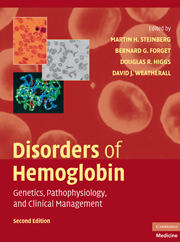Book contents
- Frontmatter
- Contents
- List of Contributors
- Foreword, by H. Franklin Bunn
- Preface
- Introduction, by David J. Weatherall
- SECTION ONE THE MOLECULAR, CELLULAR, AND GENETIC BASIS OF HEMOGLOBIN DISORDERS
- SECTION TWO PATHOPHYSIOLOGY OF HEMOGLOBIN AND ITS DISORDERS
- SECTION THREE α THALASSEMIA
- SECTION FOUR THE β THALASSEMIAS
- SECTION FIVE SICKLE CELL DISEASE
- SECTION SIX OTHER CLINICALLY IMPORTANT DISORDERS OF HEMOGLOBIN
- SECTION SEVEN SPECIAL TOPICS IN HEMOGLOBINOPATHIES
- SECTION EIGHT NEW APPROACHES TO THE TREATMENT OF HEMOGLOBINOPATHIES AND THALASSEMIA
- Index
- Plate section
Foreword, by H. Franklin Bunn
Published online by Cambridge University Press: 03 May 2010
- Frontmatter
- Contents
- List of Contributors
- Foreword, by H. Franklin Bunn
- Preface
- Introduction, by David J. Weatherall
- SECTION ONE THE MOLECULAR, CELLULAR, AND GENETIC BASIS OF HEMOGLOBIN DISORDERS
- SECTION TWO PATHOPHYSIOLOGY OF HEMOGLOBIN AND ITS DISORDERS
- SECTION THREE α THALASSEMIA
- SECTION FOUR THE β THALASSEMIAS
- SECTION FIVE SICKLE CELL DISEASE
- SECTION SIX OTHER CLINICALLY IMPORTANT DISORDERS OF HEMOGLOBIN
- SECTION SEVEN SPECIAL TOPICS IN HEMOGLOBINOPATHIES
- SECTION EIGHT NEW APPROACHES TO THE TREATMENT OF HEMOGLOBINOPATHIES AND THALASSEMIA
- Index
- Plate section
Summary
The study of hemoglobin continues to be a rewarding endeavor. Cumulative progress since the turn of the last century has laid cornerstones in protein chemistry and molecular genetics and has provided a wealth of insight into the pathogenesis of some of the world's most prevalent and devastating disorders. The first edition of Disorders of Hemoglobin, published 8 years ago, was a comprehensive compilation and analysis of the basic science of hemoglobin and its application to the thalassemias, sickle cell disease, and other globin mutants that spawn a wide range of clinical phenotypes. This second edition now presents an updated overview of all aspects of the hemoglobin story as well as a detailed account of the impressive advances that have been made in biochemistry, genetics, and clinical investigation.
Hemoglobin boasts a proud history. By the end of the nineteenth century, it was well established that hemoglobin was a composite of protein and heme that could reversibly bind oxygen and that this substance was found in almost all living creatures. Entry into the twentieth century marked the dawn of quantitative physiology, biochemistry, and the application of the scientific method to medicine. All three of these developing disciplines owe their early impetus to hemoglobin and the lessons learned from this remarkable molecule. Physiologists from Scandinavia (Bohr and Krogh) and England (Barcroft, the Haldanes, and Roughton) made accurate equilibrium and kinetic measurements of oxygen–hemoglobin binding as a function of pH and thereby provided a mechanistic understanding of the reciprocal transport of oxygen from lung to tissues and of acid waste from tissues to lung.
- Type
- Chapter
- Information
- Disorders of HemoglobinGenetics, Pathophysiology, and Clinical Management, pp. xv - xviPublisher: Cambridge University PressPrint publication year: 2009



